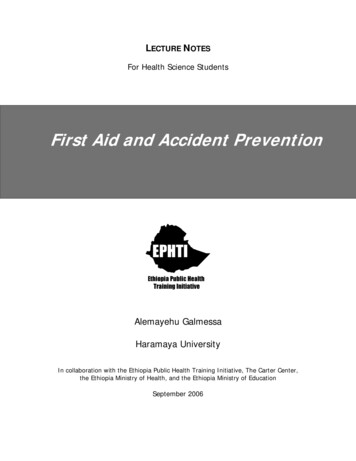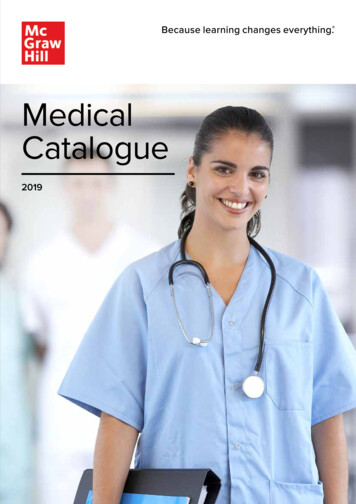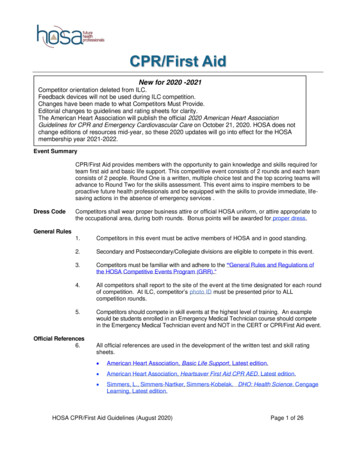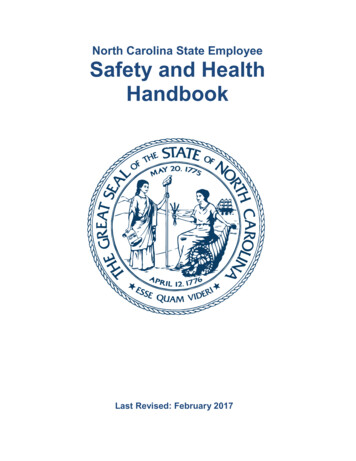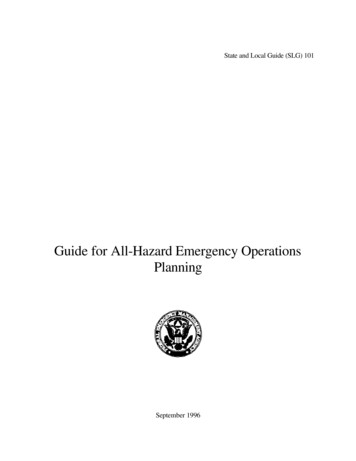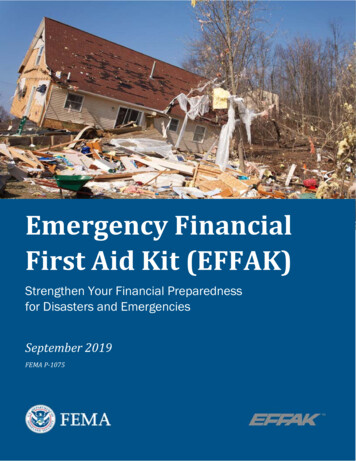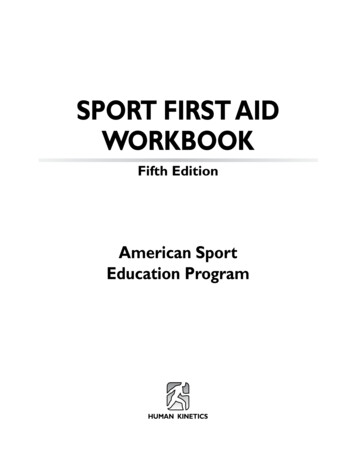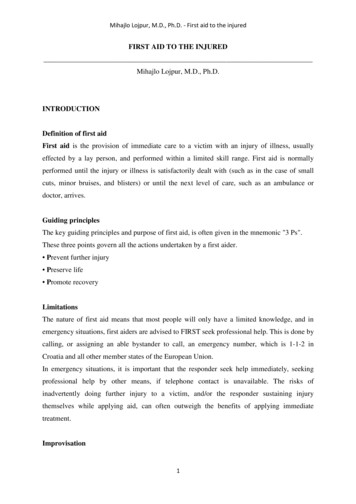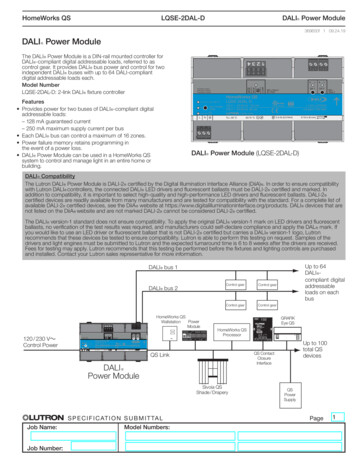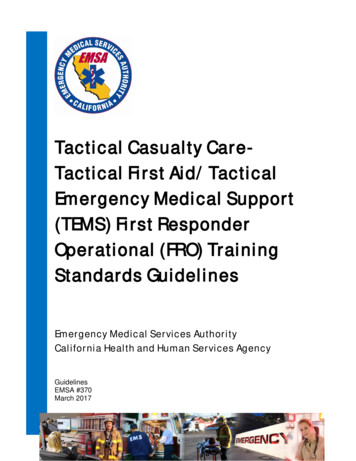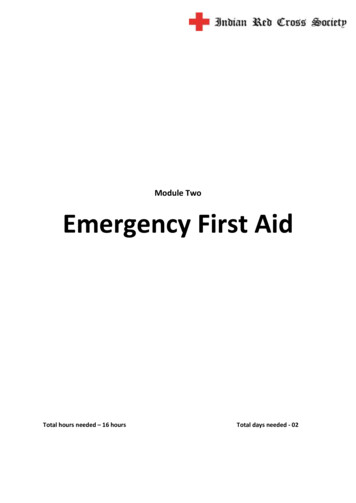
Transcription
Module TwoEmergency First AidTotal hours needed – 16 hoursTotal days needed - 02
1 Page
Table of Content1.Principles and Practices of First Aid2.Assessment in First Aid3.Structure and Function of essential body parts4.Basic life support (resuscitation)5.First aid in emergencies6.First aid kit and use of materials7.Triage8.Safe handling and transportation of patients2 Page
3 Page
Principles and Practices of First AidObjective of this sessionParticipants learn what is first aid and why is it performed. They will learn in this session theaim of first aid and will be introduced to its basic concepts. After the session participants areexpected to know well the ‘golden rules’ in first aid.Session PlanTime20 MinutesTopicShort introduction with FirstAid.20 MinutesGolden Rules Of First Aid20 MinutesBasics of rapid responseMethodologyClassroom training, brainstormingsharing experiences, storytelling andQ&AClassroom training, brainstormingsharing experiences, storytelling andQ&AClassroom training, brainstormingsharing experiences, storytelling andQ&ATools and Resources requiredFlipcharts; Cut pieces of cards; Markers; Tape and chart standsKey Messages1.2.3.First aid is an application of skills to preserve life, Prevent deterioration and Promoterecovery.It is a vital skill, that requires learningGolden rules of First aid includes Safety first, perform tasks in a logical order.Content:First aid sometimes referred to as EMERGENCY AID is the first skilled [acceptable] assistance given toa victim (sick or injured) on the occurrence of accident or sudden illness in order to preserve life,prevent further injury and relive suffering until qualified medical care is available.To be effective at any form of true first aid you need to obtain some training or instruction. Thefollowing basic first aid instructions are designed to assist you in learning the skill.First aid is an application of skills and techniques, in a logical and prioritized sequence. You need tolearn first aid as you will not be able to guess the priorities. You can say ‘first aid is just commonsense’, but it is so much more.The scope of first aid is to apply a consistent set of standards, and treatment, in a logical order.Victim assessment by a first aider is to identify injuries, treat, and transport victims.4 Page
GOLDEN RULES OF FIRST AID Do the first thing first; this includes assessing the situation for any immediate danger, quicklyand methodically without panicking, giving priority to the most urgent situation / condition.Remove the victim from the cause of injury or the cause of injury from the victim.Resuscitate the victim, if necessary and carry out general treatment of unconsciousness.Loosen all tight clothing or materials around the victim’s neck waist, wrist, etc.Arrest bleeding, cover all wounds, burns or scalds and immobilize all fractures.Do not allow people to crowd a victim and do not move a victim unless you really have to(dangerous environment, risk of falling debris, explosion etc)Reassure the victim and get help as soon as possibleImprovise all necessary materials, which are not readily available.Guide against or treat for shockDispose/transport the victim properly.Principles of First AidThe key guiding principles and purpose of first aid, is often denoted by 3 Ps.1. Prevent further injuries2. Preserve life3. Promote recoveryRapid Responses to Disasters and duties of rescuerWhen disaster strikes, individuals within the affected community and neighbouring communities arethe first to respond. Preparedness can make the difference between life and death.A damage assessment survey should follow three key principles:a. Look: Make a thorough visual inspection of the damage-affected area;b. Listen to all sources of information - the community, government records, and mediareports;c. Understand the gravity of the dangers and the suffering of victims as well as thecapacity to respond.The first job of a rescuer is to remain calm and assess the area to determine the extent andparticulars of the damage identify any hazards or obstacles to rescue, and gauge whether furtherdamage is likely. The information collected will be crucial in planning the best approach to rescue.Rescuers can get this information by speaking with local leaders and residents within the locality. Itis important that appropriate help as per assessment is called. It is important to understand that firstaid has limitations and does not take place of a professional medical treatment.The first actions by First Aiders: DR. CABD – Danger assessment for self and victimR – Responsiveness of the victimC – Check and assess for pulseA – Assess and ensure clear airwayB – Check if person is breathingMaterials available for this session: 1. First Aid PP.ppt5 Page
Assessment in First AidObjective of this sessionIn this session participants would be introduced to some important rules of assessingcasualty, its process and points that need to be remembered while doing it. After thesession participants will be able to recognise signs and symptoms of condition that requiresimmediate support.Session PlanTime30 Minutes45 Minutes45 MinutesTopicSituational assessmentCasualty assessmentAssessing and managing vitalsMethodologyClassroom training and Q&AClassroom training and Q&AClassroom training and Q&ATools and Resources requiredFlipcharts; Cut pieces of cards; Markers; Tape and chart standsKey Messages1. Signs in casualty can be seen, felt and heard.2. Signs and symptoms help in an assessment.3. Where possible history taking from the victim either supports or confirms madeassessment.ContentASSESSMENT: This is the way we decide on the primary problems, a victim is suffering from.To do this in a methodical way we use a system, known as Primary and Secondary survey.This is vital and should be used in all emergency situations so you will not forget. Victimshave to be dealt with in a methodical prioritized fashion.This site will be set out with life threatening situations and work towards more minoroccurrences. We will start with accidents and then medical emergencies. First in each will beimmediately life threatening conditions followed by life threatening and then to potentiallylife threatening, and onto minor. It should be borne in mind that some conditions, which arethought minor and commonplace, such as a simple faint, are in fact potentially lifethreatening, unless dealt with correctlyFollowing a disaster, the typical situations requiring First Aid are: Breathing and/or circulation problems; Severe bleeding; Shock;6 Page
Fainting;UnconsciousnessFracture;Head injuryThe aims of First Aid are to: Preserve life Prevent the worsening of the casualty’s medical condition Promote recovery Provide safe transportation to the nearest health care facilityImportant Points to be remembered by First-Aiders1. First-Aiders must always remain calm and assess the situation first beforerushing to help the victim.2. First Aiders must ensure to remove any dangers from the casualty, or removethe casualty from dangers, and prevent the crowding of casualties bybystanders.3. It is important that the First-Aiders -call for appropriate help as per theassessment of the situation.4. As most first aid treatment does involve touching the victim, it is very importantthat the First-Aider gains their permission, so as to avoid causing offence ordistress.5. It is important to understand that first aid has its limitations and does not takethe place of professional medical treatment.6. First Aiders should also take care to listen to any remarks or requests a casualtymakes.7. The First Aider’s responsibility ends when the casualty is handed over to the careof a competent health provider.When faced with a casualty, a First Aider must quickly determine the most appropriatecourse of action. The First Aider must assess the casualty and the area to gather all relevantinformation based on the history of the event leading to the injuries and the casualty’s signsand symptoms.DIAGNOSIS: This is the way of finding out the state of the casualty, this is made on the basisof the signs, symptoms and history of the condition.SIGNS: Signs of a condition are the physical variation from normal, which can either be seen,felt, smelt or heard. Signs that can be seen include;o Irregular or unnatural movementso Swellingo Tendernesso Bleedingo Discoloration7 Page
Bleeding and woundso Broken bones in the case of open fractureo Deformity etc.Signs which can be felt include;o High or low body temperatureo Deformityo Dampness etc.o Signs which can be smell includeo Smell of alcoholo Odour of Acetone (pear drops)o Smell of burnso Smell of solvents such as keroseneo Smell of fumes, etc.Signs which can be heard include;o Crepitus [grating bones]o Noisy breatho Speech, etco SYMPTOMS: Symptoms of a condition are the feelings or sensation which the victimexperiences. The victim sometimes may complain of these feelings. Examples ofsymptoms are: adache etc. HISTORY: History is any information relating to an incident/accident or illness. Thisinformation can be obtained by asking questions related to the incident from thevictim [if conscious], or from a passer-by or from those who witness the incident.Remember history should include prior to the incident as well. This is important, as ifthe victim has a pre-existing illness, it may change the treatment regimen you adopt.The sources of history are not only from the victim, victim or those who witness theincident. Other sources of historyHow to assess a casualtyOnce the First Aider has established that the casualty is breathing and has a strong pulse, heor she can assess the casualty for imminent threats and injuries. Whether the casualty isconscious or unconscious, the assessment should proceed as follows8 Page
Assess scene safetyApproach the patients with care, makingsure that there is no danger to you, thepatients, or any bystanders. Be aware ofhazards from electricity, gas etc.Patient’s assessmentsCarefully shake the patients shoulder andshouts:“Hello can you hear me?”If the victim responds:1. Leave the victim in the position inwhich you found him, provided thereis no further danger.2. Try to determine what is wrong withthe victim. 3. Call for help if needed.4. Reassess the victim regularly The key principle to assessment of a patient is oftendenoted by the acronym ABC. This stands for:AirwayBreathingCirculation9 Page
Change from “A–B–C” to “C–A–B.” A major change in basic life support is a step away from the traditionalapproach of airway–breathing–chest compressions (taught with the mnemonic “A–B–C”) to first establishinggood chest compressions (“C–A–B”). There are several reasons for this change. Most survivors of adult cardiac arrest have an initial rhythm of ventricular fibrillation (VF) or pulse lessventricular tachycardia (VT), and these patients are best treated initially with chest compressions andearly defibrillation rather than airway management.Airway management, whether mouth–to–mouth breathing, bagging, or endotracheal intubation, oftenresults in a delay of initiation of good chest compressions. Airway management is no longerrecommended until after the first cycle of chest compressions –– 30 compressions in 18 seconds. The30 compressions are now recommended to precede the 2 ventilations, which previous guidelines hadMaterialsatavailablesession:recommendedthe startforofthisresuscitation.Only a minority of cardiac arrest victims receive bystander CPR. It is believed that a significant obstacleto bystandersperforming CPR1. Assessmentppt. is their fear of doing mouth–to–mouth breathing. By changing the initialfocus of resuscitationchest compressionsrather than airway maneuvers, it is thought that more2. Action intoEmergencyppt.patients will receive important bystander intervention, even if it is limited to chest compressions.Airway: The airway is the series of passages that carries oxygen to the lungs. In anunresponsive patient the tongue may fall back into the throat and block the airway. This isthe most common cause of airway obstruction in an unresponsive patient. The airway canbe opened by tilting the head back and lifting the chin. These actions draw the tongueforward away from the back of the throat.Breathing: While keeping the airway open, check whether the patient is breathingnormally. If the patient is not breathing you must breathe for him. We will show you how todo this later; for now, look, listen and feel for breathing.Agonal Breathing For several minutes after cardiac arrest, a patient may takeinfrequent gasps or air. This process is called 'agonal breathing'. This is not normalbreathing and the patient requires immediate CPRCirculation: At first responder level, the absence of breathing most likely means that thepatient's heart has stopped. Task at this point is to restore circulation. Chest compressionsare required to pump the blood, particularly to the brain. Patients should be placed lying flaton their back on a firm surface. Once these matters have been attended to, the casualty’sother injuries can be treated.If an unconscious casualty is not breathing, it may be due to one of the following causes: The head is tilted forward;The tongue is blocking the air passage due to the loss of muscular control in the throat;Saliva is lying in the back of the throat and blocking the airway due to impaired reflexes;There is a foreign body in the throat blocking the airway (e.g. vomit, dentures and weeds).10 P a g e
Opening the airway in an adultIt is essential to establish a clear airway immediately to ensure the survival of the casualty.Open and clear the airway using the chin lift position.Head tilt chin liftresulting in removal ofobstruction of airpassage Ensure the patient is on his back; if necessary roll him onto his back.Place one hand on his forehead and gently tilt the head back.Place the fingers of your other hand along the line of the jaw.Lift the chin using the fingers.These combined actions, called “head tilt chin lift”, will open the airway.Once breathing starts, place the patient in the Recovery Position.Checking for breathing Breathing:normally.While keeping the airway open, check whether the patient is breathingLook, Listen and Feel for any sign ofrespiration: Look for the rise and fall of the chest.If the casualty’s chest fails to rise,assume the airway is not fully open.Adjust the position of the head andjaw and look again; Listen for breathing sounds;Feel the air coming out of the nose ormouth.11 P a g e
Agonal Breathing For several minutes after cardiac arrest, a patient may take infrequentgasps or air. This process is called 'agonal breathing'. This is not normal breathing and thepatient requires immediate CPRCPR will be discussed in the following chapter.When the casualty is breathing independently place the person in the Recovery Position.Checking for circulationThe only reliable way of establishing lack of circulation is to check the pulse at the neck(carotid pulse). This pulse can be felt by placing the finger tips gently on the voice box andsliding them down into the hollow between the voice box and the adjoining muscle. (Thepulse at the wrist is unreliable).Feeling the Carotid PulseRadial PulsecheckingcirculationThe carotid arterialforpulsesare usuallyexamined with the patient supine and the trunk of thepatient's body slightly elevated. The patient's chin should be elevated to allow easypalpation and yet not enough to tighten theneck muscles. Checking the carotid pulse is notalways an accurate method of confirming thepresence or absence of circulation.Agonal gasps are common in the first fewminutes of a cardiac arrest (present in up to40% of victims) and are associated with highersurvival, if recognized as a sign of cardiac arrest(and treatment is begun).Agonal gasps are an indication for starting CPRimmediately.Therefore, first aid providers should begin CPR ifthe victim is unconscious (unresponsive) andnot breathing normally.Ask “Are you all right”CPR is discussed in later chapter.Materials available for this session:2. Assessment.ppt12 P a g e
Structure and Function of essential body partsObjective of this sessionThis session familiarises participants on structure of human body that may be most prone to injuryor needed for first aid access on a victim. The session provides basic information on respiration andcirculation.Session PlanTime15 minutes15 minutesTopicIntroduction with basic bodyparts useful in first aidImportant body functions –Circulation and Respiration.MethodologyClassroom training, brainstorming/group work and Q&AClassroom training, brainstorming/group work and Q&ATools and Resources requiredFlipcharts; Cut pieces of cards; Markers; Tape and chart standsKey Messages1. Skeleton provides support to the body and protection to the vital organs.2. Oxygen is essential for the support of life and is obtained from the air we breathe.3. Heart circulates blood through the body which carries blood and important nutrients for life.Content:The Human Body FrameThe skeleton forms the supporting framework of the body and consists of separate bones joinedtogether by means of cartilage, ligaments and musclesThe bones in different parts: Head and face: Skull, two cheek bones and lower jaw bone Body: Backbone or spine, the ribs and breast bone Upper limbs: Arm, forearm (long bones), palm (short bones) Hip: The pelvis Lower limbs: Thigh and leg ; long bones, feet - short bones13 P a g e
Some important body parts to know:The Skull - The bone of the head forms the skull and protects the brain inside. Injury to the headcauses bleeding from blood vessels inside the closed box; the blood is unable to escape and getscollected and presses the soft brain tissue. This leadsto headache, irritability, unconsciousness and maycause death. To avoid this it is important to place allpersons of head injury under care of medicalsupervision at the earliest.The Back Bone or Spine (Vertebral Column): Itconsists of thirty three small rounded pieces of bones.There is a central canal through which the spinal cordpasses and carries nerve impulses to and from thebrain. If there is any injury, one vertebra may bedisplaced thus the spinal cord is pressed or cut causingparalysis extremely important to handle with care allpersons who have suffered severe injury to their backor neck.The Ribs & Breast Bone (Sternum): This is called thethoracic cage which protects the heart and the lungs.An injury of the rib should be taken seriously andrequires urgent hospitalization.Tongue: The tongue is the muscular organ which lieson the floor of the mouth; it assists in tasting, andswallowing of food. In an unconscious casualty, byfalling back on the throat, the tongue tends to obstructit and thus prevent breathing.Trunk and its Contents: Inside the body, the archedmuscular partition (diaphragm) divides the trunk intotwo cavities-the upper, the chest (thorax) and thelower (abdomen). The chest contains the heart, thelungs, major blood vessels and the food pipe.The lower cavity is bounded above by the diaphragm, below by the pelvis, behind by the lower spineand in front and sides by muscular walls of abdomen. It contains several important organs - liver,spleen, stomach, pancreas (behind the stomach), intestines, kidneys and the urinary bladder andreproductive organs.Functions of the BodyThe body consists of distinct parts called organs and their special work is called function. Theessential functions of the life such as respiration, circulation, digestion, excretion, etc. are carried on14 P a g e
by a set of organs of closely related parts called as a system (e.g. the digestive system which includesthe mouth, the gullet, the stomach, the liver, the pancreas and the intestines).‘2’ important organs and their function - Lungs and Heart:Oxygen is essential for the support of life and is obtained from the air while we breathe. It is carriedto the lungs through the air passage into the blood stream and is circulated throughout the body byheart to the tissue level where exchange of gases takes place and oxygen is absorbed. Oxygen alongwith the glucose from the digested materials is carried by the blood stream to the tissues to supplyfor their growth, repair and to produce heat and energy.During the process of inspiration the chest cavity expands creating a negative pressure which inflatesthe elastic lungs, which are two in number and are situated in the chest cavity on either side of theheart. When the chest and abdominal muscles relax the chest cavity becomes smaller and the lungsgo back to their normal position due to their elasticity. Interference with the respiration may causeserious consequences like asphyxia and unconsciousness due to lack of oxygen and increase inCarbon dioxide accumulation.The heart is a muscular organ situated at the centre of the chest cavity with slight devation to theleft side. It acts as a pump to circulate blood. When the heart beatsimpure blood is passed into the lungs where it is purified. During theprocess of purification, it gives up carbon-dioxide and takes a freshquantity of oxygen. The pressure in the blood vessels (arteries and veins)varies with the beating of the heart. This pressure exerted on thearteries known as the ‘Blood Pressure’ and is recorded by the bloodpressure instrument or a rough estimate made by feeling the pulse.Fig. 25 Feeling the pulseat the wristBlood is made of cells and a liquid portion called plasma which contains(Average pulse rate inproteins, enzymes and other important ingredients. An average adultadults – 72/min.)has a blood volume of five to six litres which keeps on circulating in thesystem and carries oxygen from the lungs to all parts of the body and collects the waste productswhich are partly excreted by the kidneys and the lungs, whenever blood comes in contact with someexternal material it tends to solidify forming a clot to stop further bleeding.Materials available for this session:3. Structure and Function of Body parts.ppt15 P a g e
Basic life support (Resuscitation)Objective of this sessionThis session will help participants understand about Cardio Pulmonary Resuscitation: What it is? Why is it done? When to do it? How to do it?Session PlanTime45 MinutesTopicFirst aid in Airway Obstruction45 MinutesWhat is Recovery position?60 MinutesPrinciples and practice ofCardio PulmonaryResuscitationMethodologyClassroom training, sharingexperiences, film and Q&AClassroom training, sharingexperiences, film and Q&AClassroom training, sharingexperiences, film and Q&ATools and Resources requiredFlipcharts; Cut pieces of cards; Markers; Tape and chart standsKey Messages2. Airway obstruction in unconscious victim must be assessed and removed if possible.3. CPR is an emergency procedure which is performed in an effort to manually preserve intactbrain function until further measures are taken to restore spontaneous blood circulation andbreathing in a person.4. In a CPR press down on the sternum at least 2 inches (5-6 cm) at a rate of at least 100 perminute (nearly 2 compressions each second) but no more than 120 per minute.5. In a drowning victim the priority should be upper airway management and rescue breaths tobegin with the CPR.Content:This module includes basic life support (BLS) and basic paediatric life support (BPLS) for eachsituation.Airway obstructionForeign body airway obstruction (FBAO) is one of the more common life threatening emergenciesthat is seen and can be treated by the lay public.16 P a g e
GuidelinesCombination of back blows followed by chest compression should be used for clearance of FBAO inconscious infants 1 year old Chest thrusts, back blows or abdominal thrusts are equally effective for relieving FBAO inconscious adults and children 1 year old These techniques should be applied in rapid sequence until the obstruction is relieved; morethan one technique may be needed in conscious adults and children 1 year oldSigns of choking include: Coughing, either forcefully or weaklyClutching the throat with one or both handsInability to cough, speak, cry or breatheMaking high-pitched noises while inhaling or noisy breathingPanicBluish skin colourSometimes, the person may cough weakly or make high-pitched noises, which indicates heor she is not getting enough air to stay alive.Common Causes:The most common cause of choking in adults is airway obstruction caused by food. In infants andchildren, reported cases of choking occur while eating or with non-food items such as coins or toysduring games.Action:Foreign bodies may cause either mild or severe airway obstruction. It is important to ask theconscious victim “Are you choking?”For adults and children 1 year oldIf the victim shows signs of mild airway obstruction:Encourage continued coughing, but do nothing else.Aggressive treatment, with back blows, abdominal thrustsand chest compression, may cause potentially seriouscomplications and could worsen the airway obstruction.Victims with mild airway obstruction should remain undercontinuous observation until they improve, because severeairway obstruction may develop.If the victim shows signs of complete airway obstructionand is conscious: Apply up to five back blows as follows: 1.Stand to the side and slightly behind the victim. 2. Supportthe chest with one hand and lean the victim well forward sothat when the obstructing object is dislodged, it comes outof the mouth rather than further down the airway. 3. Giveup to five sharp blows between the shoulder blades with theheel of your other hand. 4. Check to see if each back blowhas relieved the airway obstruction. The aim is to relieve the17 P a g e
obstruction with a blow/slap, not to necessarily give all five.If five back blows fail to relieve the airway obstruction, give up tofive abdominal thrusts as follows: 1. Stand behind the victim andput both arms around the upper part of the abdomen. 2. Lean thevictim forward. 3. Clench your fist and place it between theumbilicus and the lower rib area. 4. Grasp this hand with yourother hand and pull sharply inwards and upwards. 5. Repeat up tofive times. 6. If the obstruction is still not relieved, continuealternating five back blows with five abdominal thrusts.If the victim becomes unconscious: 1. Support the victim, whilecarefully lowering him or her to the ground. 2. Immediately call formedical support. 3. Begin cardiopulmonary resuscitation (CPR) atthe compression part of the sequence.For infants ( 1 year old)If the victim shows signs of mild airway obstruction: Continue to watch the infant, but do nothingelse. Aggressive treatment with back blows and chest compression may cause potentially seriouscomplications and could worsen the airway obstruction. Victimswith mild airway obstruction should remain under continuousobservation until they improve, because severe airway obstructionmay develop.If the victim shows signs of complete airway obstruction and isconscious: Apply up to five back blows as follows: 1. Lay the infantface down along your arm with the head lower than the body.Support the infant in a head downward, prone position, to enablegravity to assist removal of the foreign body. 2. A seated or kneelingrescuer should be able to support the infant safely across his or herlap. 3. Support the infant’s head by placing the thumb of one handat the angle of the lower jaw, and one or two fingers from the samehand at the same point on the other side of the jaw. Do notcompress the soft tissues under the chin. 4. Give up to five sharpblows between the shoulder blades with the heel of your otherhand. 5. Check to see if each back blow has relieved the airwayobstruction. The aim is to relieve the obstruction with a blow/slap,not to necessarily give all five.If five back blows fail to relieve the airway obstruction, give up tofive chest thrusts as follows: 1. Turn the infant into a headdownward, supine position. This is achieved safely by placing thefree arm along the infant’s back and encircling the back part of thehead with the hand. Support the infant along your arm, which isplaced down (or across) your thigh. 2. Find your landmarks, twofingers below the nipple line. 3. Give chest thrusts (compressapproximately 1/3 of the depth of the chest). These are similar tochest compressions but sharper and delivered at a slower rate. 4.Repeat up to five times. 5. If the obstruction is still not relieved,continue alternating five back blows with five chest thrusts.18 P a g e
If the victim becomes unconscious or is found unconscious: 1. Support the victim, while carefullylowering him or her to a firm surface. 2. If medical support has not arrived or been called,immediately call for medical help. 3. Open the airway. 4. Give 2 to 5 rescue breaths. During the firstattempts at rescue breaths, if a breath does not make the chest rise, reposition the head beforemaking the next attempt. 5. Begin cardiopulmonary resuscitation (CPR) at the compression part ofthe sequence.Aftercare and referral for medical examination: After successful treatment for FBAO, foreignmaterial may nevertheless remain in the upper or lower respiratory tract and cause complicationslater. Victims with a persistent cough, difficulty swallowing or the sensation of an object being stillstuck in the throat should be referred for a medical examination. Another reason for medicalexamination is the possibility of serious internal in- juries resulting from abdominal thrusts or injuryto the airway from the object that was lodged and removed.CPRCardio Pulmonary Resuscitation (CPR) should begin immediately if the victim is not breathingnormally, or unconscious (unresponsive).C. CardioP. PulmonaryR. ResuscitationEssential when both breathing and heart beat are affected.Steps:1. Thumping the heart region.2. External Cardiac Compression.3. Mou
First aid is an application of skills and techniques, in a logical and prioritized sequence. You need to learn first aid as you will not be able to guess the priorities. You can say ‘first aid is just common sense’, but it is so much more. The scope of first aid is to apply a consis

